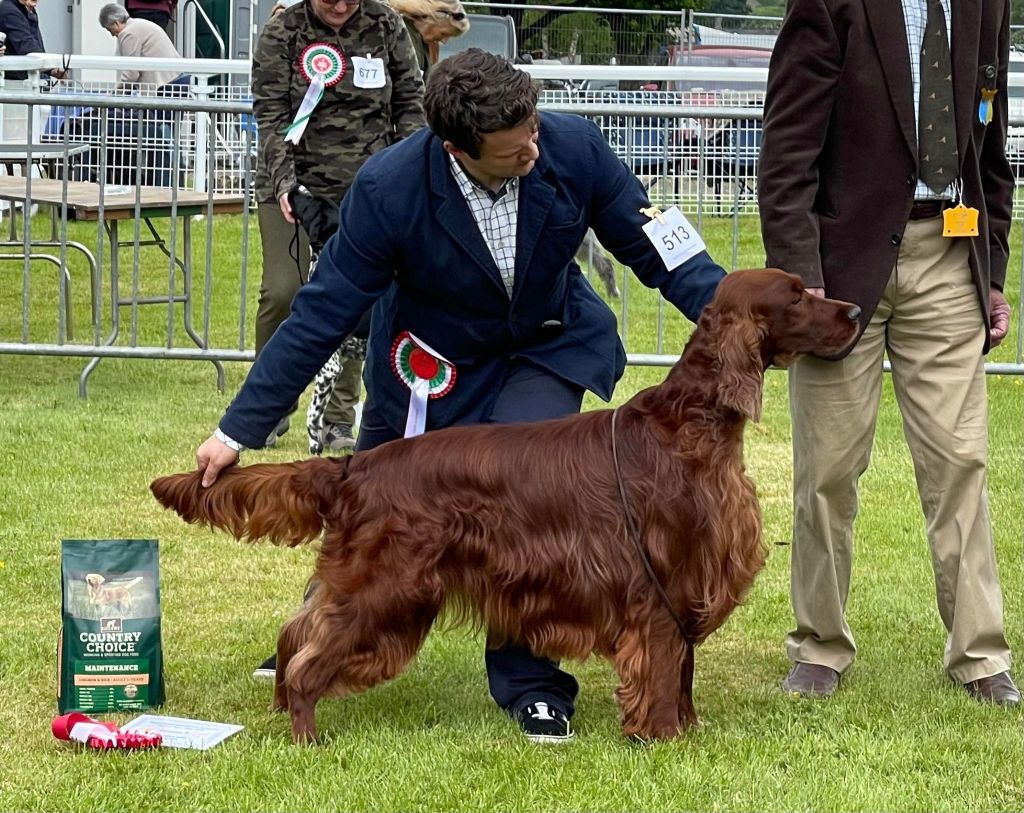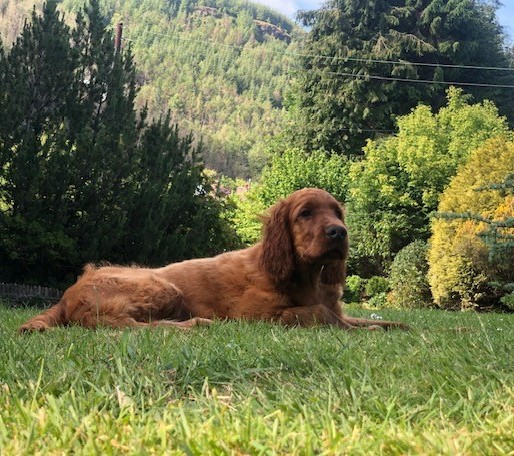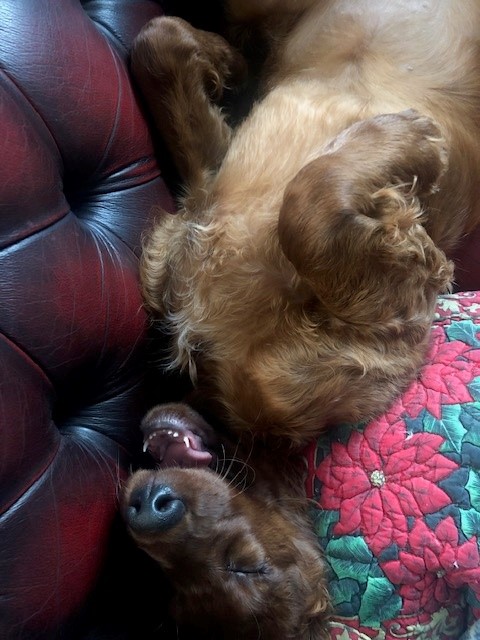About the Breed
The Irish Setter’s origin is fairly straightforward. The breed was first developed in Ireland in the early 1800s as a hunting dog to aid bird hunters in finding and retrieving prey. Hunters combined Gordon Setters, English Setters, Pointers and Spaniels to create an entirely new breed of dog: the Irish Setter. The setter is mentioned by Surflet & Markham in their 1616 “The Country Farme” as follows “There is another sort of land Spannyels which are called Setters”. As late as the nineteenth century they were still referred to as the Irish Spaniel or the Gaelic name Modder Rhu (red dog).
“Legend has it that the finest hunting dog that ever lived was a red dog named Modder Rhu. From there, the reputation of the red setters (Irish: sotar rua, literally “red setter”) who hunted the rugged terrain of the Irish moors spread far and wide. The breed was developed to track fowl with its sharp sense of smell, and to silently freeze in position so the hunter could follow and bag the prey. Holding its position also kept the dog from getting shot.” (nationalpurebreddogday.com)
Originally the most Irish were red and white, which was favoured by the hunter for ease of identification in the field. One such animal appears in a painting from c1630 of Charles I with a red and white setter. Gradually three colour strains emerged, the solid red, red and white and red with white dots or shower of hail. A Stubbs painting of 1760,“Huntsmen setting out from Southill, Bedfordshire” shows a red setter with a white blaze up the face and a little on the chest. Some believe that a “landmark” dog came along who pushed the influence in favour of the all-red dogs. Champion Palmerston was a stunning, lighter boned, red-mahogany dog who came on the scene in 1862. From him we get most of our modern-day Irish setters. In 1860 at Birmingham the first show with its own Irish setter section was held and the vast majority entered were red and white. By 1875, at the Dublin show, the solid red was more evident, with forty-three of the sixty-six dogs entered being solid red.
In 1885 the first Irish Red Setter Club was formed in Dublin and a year later they drew up the first authoritative breed description complete with a scale of points for judging. The Irish Setter Association was formed in London in 1908, which adopted the breed standard of the Club in Ireland. The standard was slightly revised in Dublin in 1930 and when the Kennel Club took responsibility for the standard in the U.K. the scale of points was dropped.
As working dogs, the Setters detected birds and flushed them out of their hiding spots. Then the hunter shot the bird, and the dog retrieved the body and brought it back.
“The breed was called the Red Setter as it differentiated it from the other two Irish breeds: the traditional Red and White and the rarely seen Hail Setter, which had white ticks in its red coat and is now believed to be extinct. Selective colour breeding and some outcrossing to get a racier build and longer head resulted in a dog which was glamorously coated, lighter in bone and finer in the head than its cousins. The breed became a great success in the show ring in the mid-19th century and overtook the Irish Red and White Setter in popularity.” (Kennel Club)
With its flowing, silky red coat, long ears, soft expression and regal bearing, this dog turns heads wherever it goes. To its owner, it is the thoroughbred of dogs.

The Irish Setter’s personality is fun loving, playful and affectionate. The standard calls for a demonstratively affectionate temperament, and anyone who has had the pleasure of raising an Irish Setter puppy can tell you exactly what that means. It is mischievous and independent, intelligent and stubborn, but always anxious to please, showering its owner with constant love.

Most Irish Setter breeders and owners will tell you that Irish Setters do not like to consider themselves dogs, but rather one of the family. They are famously good family dogs: sweet-tempered companions, rollicking playmates and tennis-ball fetchers for the children and so loyal to its family. Many would agree that the Irish Setter is the most beautiful of dog breeds.
Compared with some dogs, an Irish Setter’s shedding is not excessive. Irish Setters live 12 to 15 years. Preventative healthcare (regular vet check-ups to stay on top of any medical concerns) will help increase your Irish Setter’s lifespan and allow them to live a happy, healthy life.

Irish Setters are an active breed and require time and exercise, but they are most adaptable and will fit into any home as long as they get their share of attention and love.
A daily walk or run are a must if you wish to have a happy and adjusted Irish Setter.
From the hard-working field dog to the pampered show dog, all Irish Setters enjoy being part of the family as well as enjoying all of the comforts home life has to offer. They are very protective of their domain and will sound an alarm at anything out of the ordinary that they hear or see.

An Irish Setter is fun-loving and mischievous by nature, from puppyhood on, a sense of what is right and wrong must be instilled in your Irish Setter. You must be both patient and persistent when training setters, but never harsh, because these dogs are physically and emotionally sensitive. Also, they have long memories: once they learn something (whether right or wrong), they’ll remember it for a long time. Bad habits can be avoided from the very beginning by proper supervision and ongoing training.

Ignore the misconception that Irish Setters have more heart than brain. They’re an intelligent breed, who can be trained to remember a variety of tasks and commands. The breed can boast of Field Champions, Show Champions and Best In Show Winners at Crufts. They make excellent pets. Invest time in your dog’s grooming, exercise and training needs and you will be rewarded with an Irish Setter, who will forge a strong, lifelong bond with you and will make you smile daily.
